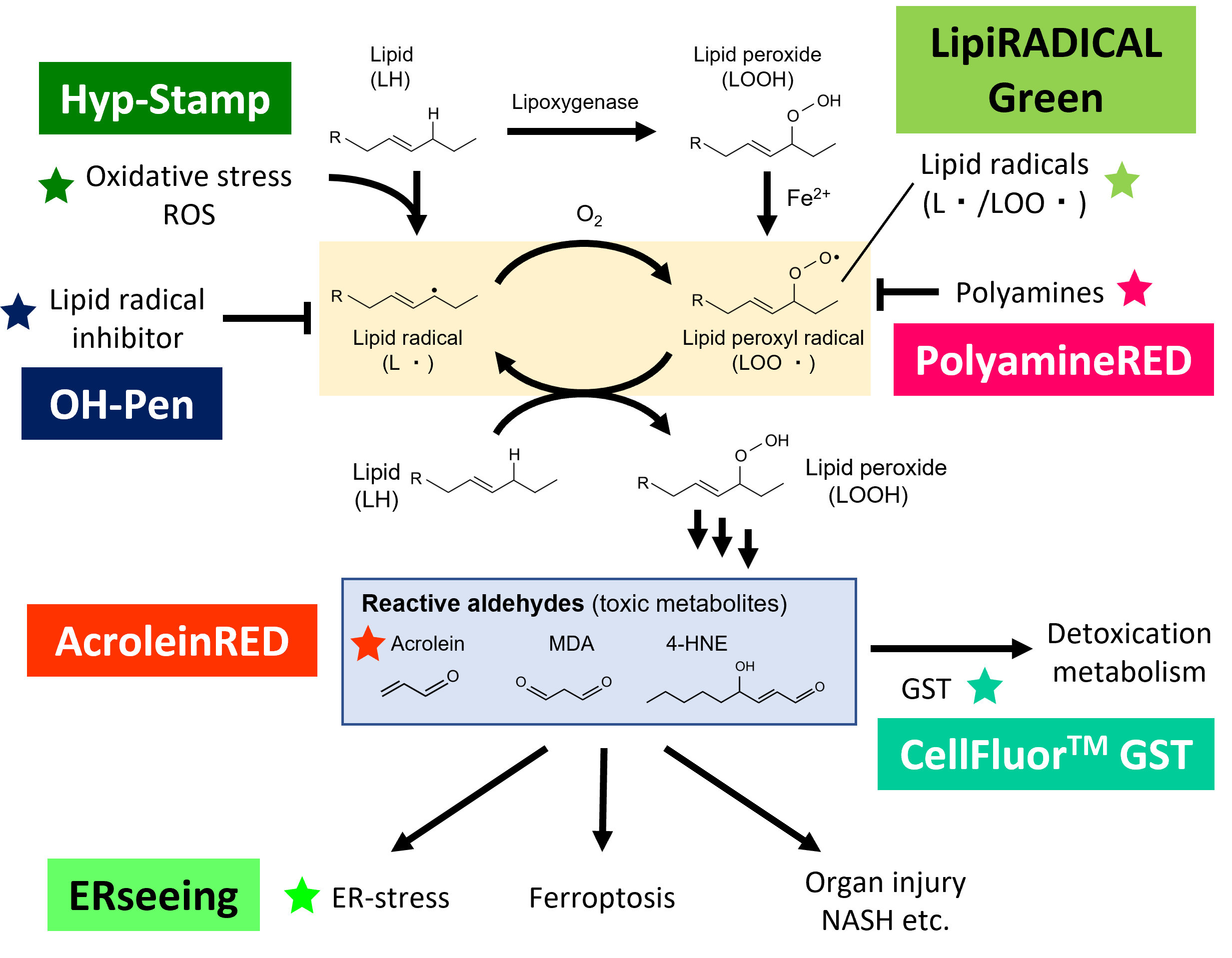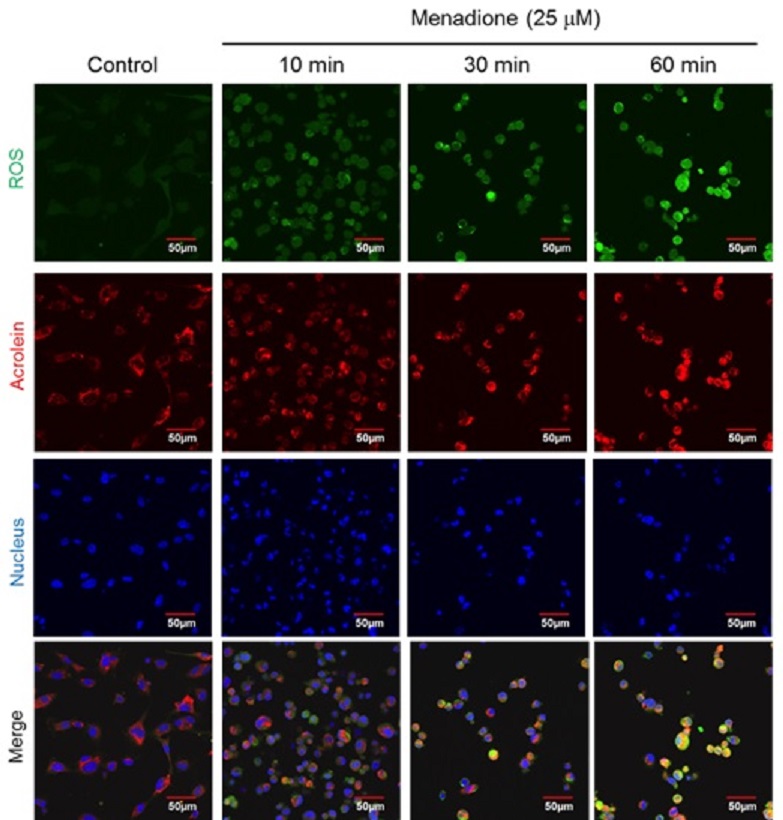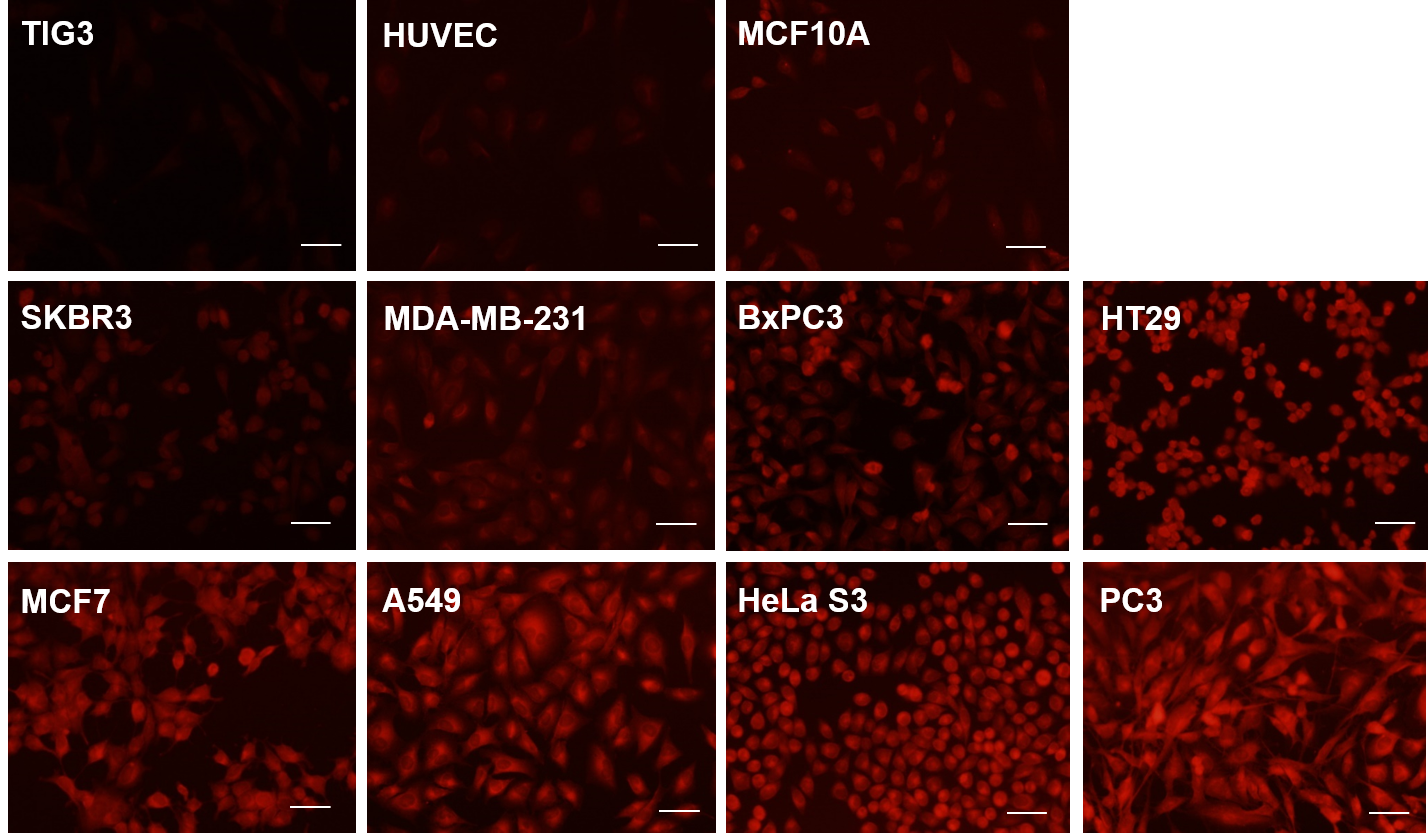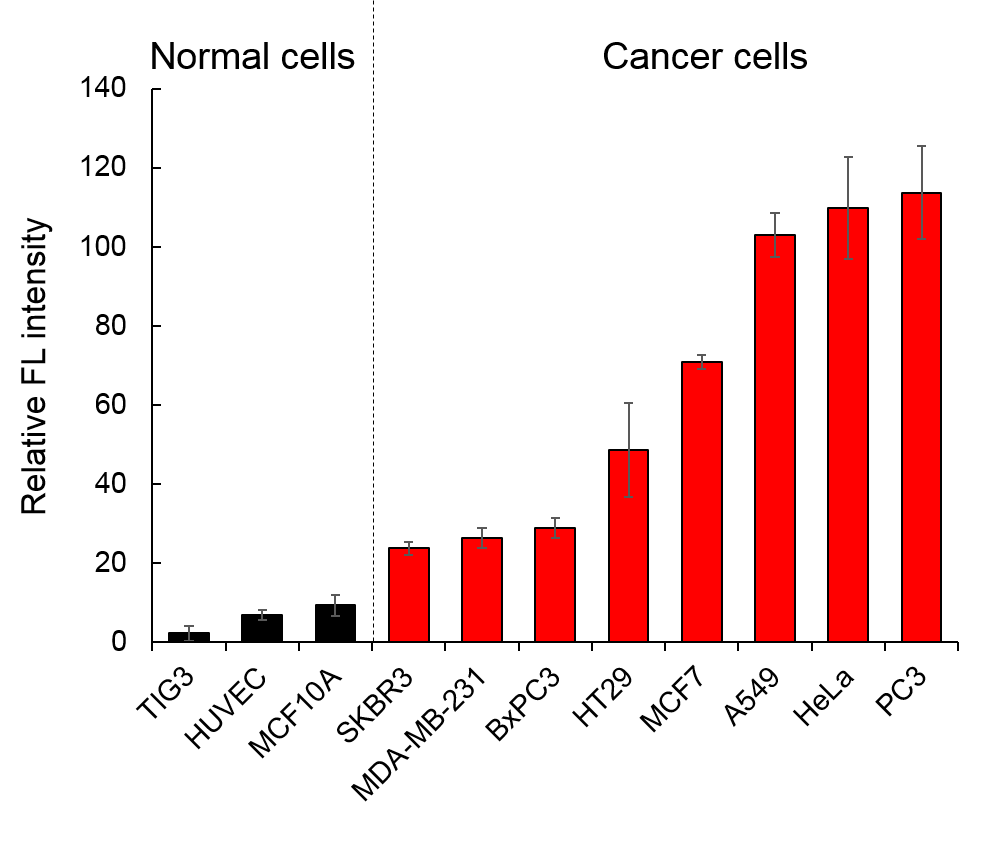Acrolein Detection Reagent in Live Cells AcroleinRED™ | Funakoshi
Date:October 01 2018Web Page No:81137

Funakoshi Co.,Ltd.

AcroleinRED™ reacts specifically with acrolein, an unsaturated aldehyde that exhibits strong toxicity, and visualizes it with red fluorescence. This reagent does not react with other unsaturated aldehydes or lipid metabolites etc., and enables easy detection and relative quantification of endogenous acrolein or acrolein produced by external stimuli in living cells.
※ This product has been commercialized with the support of Biofunctional Synthetic Chemistry Laboratory, Cluster for Pioneering Research, RIKEN.
- What is Acrolein
- Principle
- Features
- Application
- How to Use
- Application Examples
- Original Paper
- Product Information
- You may also like
What is Acrolein
Recent evidences indicate acrolein is more toxic to cells than ROS such as hydrogen peroxide (H2O2) or hydroxyl radicals. Because of its highly reactivity, acrolein in the cell immediately reacts with various biomolecules such as DNA/RNA and proteins, and subsequently impairs their functions. Acrolein has being researched for more than half-century and many detection methods were developed, such as fluorometric method, mass spectromy or antibody based detection method, etc. However, conventional methods are not appropriate for the detection in live cells and show poor selectivity and sensitivity.
Principle
AcroleinRED™ is based on phenylazide-acrolein click chemistry discovered by Drs. Katsunori Tanaka et al., RIKEN.
Phenylazide Specific Reaction with Acrolein
The phenylazide group reacts specifically and rapidly with acrolein to form the cyclic product 4-formyl-1,2,3-triazoline, which reacts with neighboring biomolecules nonspecifically to form covalent bonds.

Principle of Acrolein Detection by AcroleinRED™
There are two possible intracellular and extracellular pathways.

- ⓵ Intracellular Acrolein
AcroleinRED™ is membrane-permeable, so it permeates the cell membrane and reacts with acrolein intracellularly to form 4-formyl-1,2,3-triazoline. - ⓶ Extracellular Acrolein Released from Cell
Acrolein produced by lipid peroxidation of cell membranes are released to extracellular space. Acrolein quickly reacts with AcroleinRED™ outside cells, and the reaction product 4-formyl-1,2,3-triazoline incorporated into cells through the endocytosis pathway.
⓵, ⓶ In both pathways, the reaction product, 4-formyl-1,2,3-triazoline, reacts with biomolecules (e.g., proteins) randomly in the cells and stays inside the cell to stain the cell. ※ Since the reaction products of acrolein, the reagent and biomolecules are detected as fluorescent signals, AcroleinRED™ does not visualize the localization of acrolein. Please note that localization cannot be observed with this reagent.
Features
- AcroleinRED™ is a reagent that takes advantage of the specific and rapid reaction of phenyl azide with acrolein. By labeling acrolein produced by cells with TAMRA, acrolein can be visualized.
- Rhodamine filter sets are available. (Ex/Em: 560 nm/ 585 nm)
- No react with other unsaturated aldehydes (crotonaldehyde, trans-2-octenal, methacrolein) or styrene
- No pre-treatment and easy procedure
- High sensitivity than existing acrolein quantification methods (detection limit: 100 nM)
- Semi-quantification of acrolein amount by fluorescence intensity
Application
- Semi-quantification of acrolein production at steady state
- Semi-quantification of effects in acrolein production by external stimuli (e.g., drug treatment)
※ AcroleinRED™ cannot be applied into localization study of intracellular acrolein.
How to Use

Workflow of AcroleinRED™
Application Examples
Selectivity of Phenylazide to Acrolein
| Detection Reagent | phenylazide  |
||||
|---|---|---|---|---|---|
| Target | acrolein  |
methacrolein  |
crotonaldehyde  |
trans-2-octenal  |
styrene  |
| Reaction | 47% | <1% | <1% | <1% | <1% |
Observation of Oxidative Stress-induced Acrolein Production
HUVECs were pretreated with 0-1,000 μM Hydrogen Peroxide (H2O2) for 2 hours and subsequently treated with 10 μM AcroleinRED™ for 30 min, then observed under live cell condition. In the absence of H2O2, the acrolein endogenously produced by HUVECs was observed. Intracellular TAMRA signals were increased in H2O2 dose-dependent manner compared with the endogenous acrolein level.

Observation of Reactive Oxygen Species (ROS)-induced Acrolein Production
HUVECs were treated with 25 μM Menadione, an inducer of reactive oxygen species (ROS), for 0, 10, 30, 60 min and subsequently co-stained with ROS detection dye and AcroleinRED™. By the addition of Menadione, ROS were immediately increased, however, the acrolein level increased belatedly.
Comparison of Acrolein-Production Levels of Various Cell lines by AcroleinRED™
Relative levels of acrolein production were compared in three normal human cells and eight cancer human cell lines using AcroleinRED™. Red fluorescent signals of cancer cells were much higher than that of normal cells. Furthermore, AcroleinRED™ revealed that acrolein-production levels of eight cancer cell lines are significantly different from each other
Visualization of Tumors From Breast Gland Tissues
Original Paper
- A. R. Pradipta, M. Taichi, I. Nakase, E. Saigitbatalova, A. Kurbangalieva, S. Kitazume, N. Taniguchi, K. Tanaka, ACS Sens., 1, 623~632 (2016).
Uncatalyzed Click Reaction between Phenyl Azides and Acrolein: 4-Formyl-1,2,3-Triazolines as “Clicked” Markers for Visualizations of Extracellular Acrolein Released from Oxidatively Stressed Cells. - T. Tanei, A. R. Pradipta, K. Morimoto, M. Fujii, M. Arata, A. Ito, M. Yoshida, E. Saigitbatalova, A. Kurbangalieva, J. Ikeda, E. Morii, S. Noguchi, and K. Tanaka, Adv. Sci., 1801479 (2018)
Cascade reaction in human live tissue allows clinically applicable diagnosis of breast cancer morphology. [PMID:30693189]
Product Information
[Date : January 09 2026 00:09]
| Detail | Product Name | Product Code | Supplier | Size | Price | ||||||||||||||||||||||||||||||
|---|---|---|---|---|---|---|---|---|---|---|---|---|---|---|---|---|---|---|---|---|---|---|---|---|---|---|---|---|---|---|---|---|---|---|---|
|
AcroleinRED, Cell-based Acrolein Detection Reagent DatasheetThis may not be the latest data sheet. |
FDV-0022 | FNAFunakoshi Co.,Ltd. | 0.5 mg | $380 | |||||||||||||||||||||||||||||||
|
|
|
||||||||||||||||||||||||||||||||||
[Date : January 09 2026 00:09]
AcroleinRED, Cell-based Acrolein Detection Reagent
DatasheetThis may not be the latest data sheet.
- Product Code: FDV-0022
- Supplier: FNA
- Size: 0.5mg
- Price: $380
| Description |
AcroleinRED is the world first cell-based acrolein-detection reagent in live cell condition without any pre-treatment and cell lysis. AcroleinRED specifically reacts with either extracellular or intracellular acrolein, and labels acrolein with TAMRA (red fluorescence). |
||
|---|---|---|---|
| Storage | -20°C | CAS | |
| Link |
|
||
You may also like

CONTACT
export@funakoshi.co.jp
- ※Prices on our website are for your reference only. Please inquire your distributor for your prices.
- ※Please note that Product Information or Price may change without notice.





